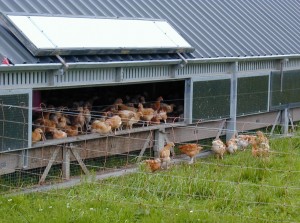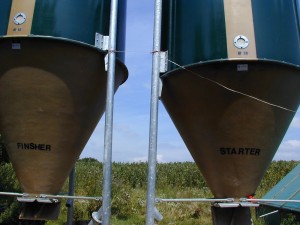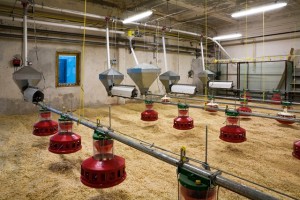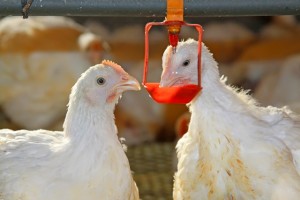Poultry Diseases
Footpad dermatitis
Also known as: Pododermatitis, Foot Burn
Footpad dermatitis (FPD) is a condition characterized by lesions on the feet of poultry. The associated lesions can vary in size. There are a number of things that can influence whether or not birds show incidence of FPD. The biggest single factor is the corrosive effect of wet or damp bedding resulting from high levels of feces. Water provision, stocking density, climatic conditions, ventilation and even feed can all have an effect.
The development of dermatitis starts as an erosion of the skin of the foot, which can look like a dirty mark that can develop into broken painful ulcers if the skin gets damaged. The disease is diagnosed by the observation of inflamed brown-black spots on the footpad of the feet that develop into necrotic lesions that can vary in size from superficial to deep (Shepherd and Fairchild, 2010). Progressing deep ulcers may lead to chronic abscesses and fibrosis of underlying synovial structures. In chickens, the lesion can also be found on the hocks. In severe cases, ulcers can prevent birds walking normally. In severe cases, the lesion can act as an entry point for secondary infections, which can cause partial condemnation of the carcass. FPD in a flock can go unnoticed as most farmers see chicken feet as a waste product. However, it is a painful condition of welfare concern, and gives a very strong indication that there are issues with litter management, which in turn could be indicative of poor environmental conditions within a house, or feed-related issues.
The risk to free-range flocks
 Free-range flocks, and particularly organic flocks, have been shown to have a higher prevalence of FPD than those kept entirely indoors (Pagazaurtundua and Warriss, 2006). It is not always easy to identify FPD in free range birds on a farm, and this information may only become evident after slaughter, when it is easier to see marks on birds’ feet.
Free-range flocks, and particularly organic flocks, have been shown to have a higher prevalence of FPD than those kept entirely indoors (Pagazaurtundua and Warriss, 2006). It is not always easy to identify FPD in free range birds on a farm, and this information may only become evident after slaughter, when it is easier to see marks on birds’ feet.
It may be the case that birds reared outside suffer more damage to their feet from small injuries caused by sharp objects such as stones, and that these initiate the FPD lesions. It may also be the case that, since birds reared outside are slaughtered at an older age, lesions will generally tend to become worse than they would be in younger birds (Pagazaurtundua and Warriss, 2006).
Wet, muddy ranging and foraging areas, especially around the pop holes or doorways into the house, can sometimes have an effect on levels of FPD, particularly during the wetter months. Placing rubber mats around the pop holes, and covering excessively muddy areas with sand, wood chips or even bedding, may help to reduce problems.
Getting a measure of the problem and taking action
Establishing the extent of the problem in a flock does not mean that all birds need to be checked. Depending on flock size, catching and examining the feet of a sample, e.g. 10% of the flock, will provide an indication of the incidence. This is best done with assistance i.e. one person holding the bird while another cleans and carefully inspects the feet. The incidence and severity of the condition can be recorded using a scoring system, as described by Bilgili et al., 1996, and in the table form below (from de Jong and van Harn; 2012). A score of 50 or more recorded from the examination of 200 feet would clearly indicate a significant problem.
| Score | Description |
| 0 | No lesions; no or very small superficial lesions, slight discoloration on a limited area of the footpad, mild hyperkeratosis (thickening of the outer layer of the skin) or healed lesion. |
| 1 | Mild lesion; discoloration of the footpad, superficial lesions, dark papillae and hyperkeratosis. |
| 2 | Severe lesion; epidermis is affected, ulcers or scabs, signs of haemorrhages or swollen footpads. |
Bedding management
Continually standing in wet litter causes softening of the footpad, which then becomes more prone to damage (Mayne, 2005). The quality of bedding is the first thing that should be checked if there is a problem. Bedding has a number of important functions, including providing thermal insulation, moisture absorption, making a protective barrier from the ground, and importantly allowing birds to exhibit their natural scratching behavior. Bedding material must also have a reasonable drying time as well as being able to absorb moisture (Grimes et al., 2002, Bilgili et al., 2009). Dry, friable bedding is crucial to minimizing FPD. There is evidence that lesion prevalence is lower when extra litter was added during the rearing period (Ekstrand and Algers; 1997). Topping up bedding at least once per week is recommended by AWA. Moving from wet to dry litter conditions has been shown to result in rapid healing of most of the lesions, as well improved growth (Martland, 1985).
There are various alternative bedding materials. Chopped straw is preferable to long straw and wood shavings are more absorbent than long straw (Ekstrand and Algers; 1997). If the house is on a slope, putting straw down first with wood shavings on top can help stop bedding moving and leaving bare patches.
Spillage from drinkers
Potential sources of dampness should be checked. Water drinkers are potential sources of dampness, either from leakage or from birds spilling water. Using small cups instead of bell drinkers can reduce bedding dampness (Ekstrand and Algers; 1997), as can the use of water nipples (Ekstrand et al., 1997). The number of drinkers available to a flock can also be important as too few drinkers (or too many) can cause excessive crowding and competition around the equipment that may cause an increase in water spillage and litter dampening. A similar trend has been observed with feeders, as a high density of feeders could be related to a better dispersal of the birds on the total floor area (Ekstrand et al., 1997). Drinkers that are too low, or have the water pressure set too high, can increase the risk of wetter floors (Shepherd and Fairchild, 2010).
Although there is evidence of the relationship with stocking density, very high stocking densities increase the risk of moisture build-up, and hence an increased risk of FPD (Shepherd and Fairchild, 2010). We promote stocking densities that enable chickens to exhibit natural behavior, and under such conditions, provided other contributory factors are also in place, there will also be reduced risk of FPD. Simply lowering stocking density without regard to the environment that the birds experience is not sufficient (Martrenchar et al., 2002).
The cause of high moisture bedding may be more complex than a failure to put enough dry bedding in the house. Climatic conditions, ventilation and even feed can all have an effect.
The condition has been recorded more frequently in flocks during the winter, and there is also a strong correlation with ambient relative humidity (McIlroy et al., 1986; Bruce et al., 1990; Haslam et al., 2007), although Wang et al (1998) showed that when the air temperature was above 68oF , an increasing moisture content in the litter was associated with an increasing incidence of foot pad dermatitis. The relationship with relative humidity is most likely concerned with controlled temperature and ventilation in the house rather than climatic (Shepherd and Fairchild, 2010).
Nutrition and feeding

There are feed related issues that pre-dispose birds to footpad dermatitis, and these are largely related to the consistency of the resulting feces.
Diets high in plant-based proteins have been shown to predispose birds to FPD (Nagaraj et al., 2007). Birds fed all-vegetable diets based exclusively on corn and soybean meal have an increased potential to develop footpad dermatitis as well producing high moisture feces (Eichner et al., 2007). Birds fed high fat density diets are also more prone to FPD, as a result of the production of more viscous feces (Bilgili et al., 2006). Shepherd and Fairchild (2010) cite research that has shown certain sticky indigestible carbohydrates (non-starch polysaccharides NSPs) from plant sources, especially soybean meal, may contribute to FPD, in that the feces produced are more caustic and may cause damage to the epidermis and keratin layers of the feet. Feeds high in these NSPs can be improved with addition of NSP-degrading enzymes (Choct et al., 1995), although the preference would be to feed more suitable diets.
High salt content diets can result in higher moisture droppings, poor litter conditions and hence increased risk of dermatitis (Harms and Simpson, 1982). Nutrients such as biotin, riboflavin, pantothenic acid, and the sulfur amino acids such as methionine affect the structural components of the skin, although there is little evidence to show the benefits of supplementation on the incidence of FPD (Shepherd and Fairchild, 2010).
Genetic factors
Breed and crossbreeds can differ in their susceptibility to FPD. In particular, slow growing breeds have been shown to be less susceptible to FPD than fast growing strains and cross-breeds (Kestin et al., 1999; Sanotra et al., 2003; Bilgili et al., 2006; Kjaer et al., 2006; Allain et al., 2009; Shepherd and Fairchild, 2010; Ask, 2010).
While it has been shown that male birds are more susceptible than females (McIlroy, 1987; Bilgili et al., 2006; Nagaraj, 2007), there is also evidence to suggest the opposite (Kjaer et al., 2006), and it may be that body weight is a more important risk factor than sex. The relatively high heritability of FPD and the low genetic correlation to body weight, means that it should be possible to select against susceptibility to FPD (Kjaer et al., 2006) and ignoring the inclusion of FPD in the breeding goal, while continuing to select for increased body weight, is likely to exacerbate the problem in commercial broiler flocks (Ask, 2010).
Please note: All the disease management pages on Farm Health Online are reviewed by a sector specialist veterinarian. This page is currently under construction and under review and the contents are therefore subject to change. The advice provided above should therefore be taken with caution, as it has not yet been approved by our panel of experts.


 British English
British English



Comments are closed.